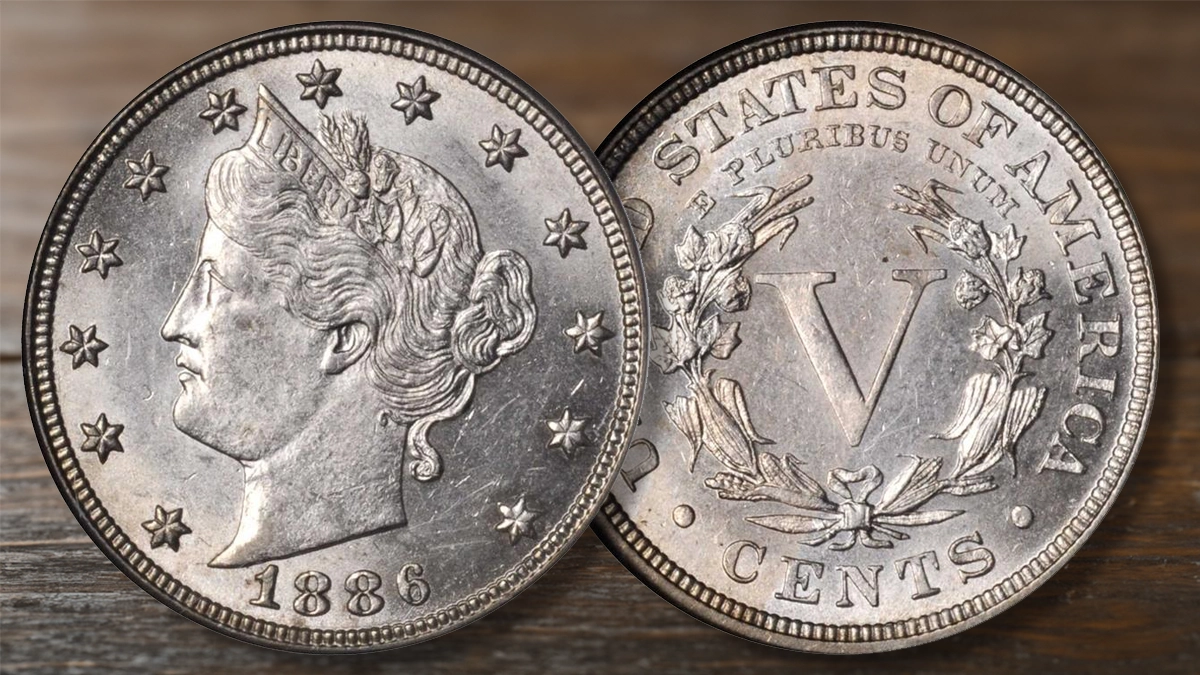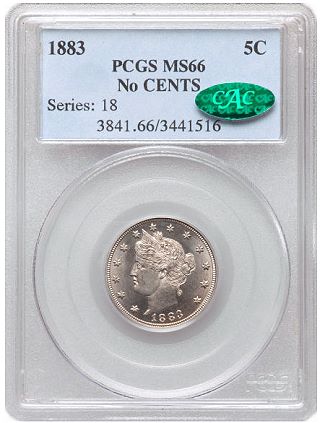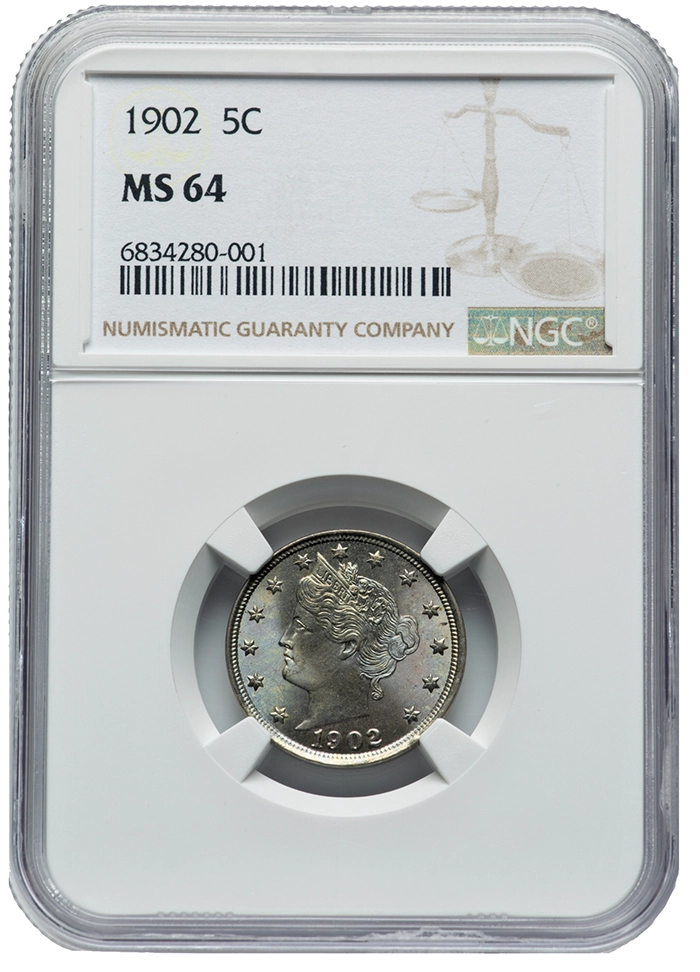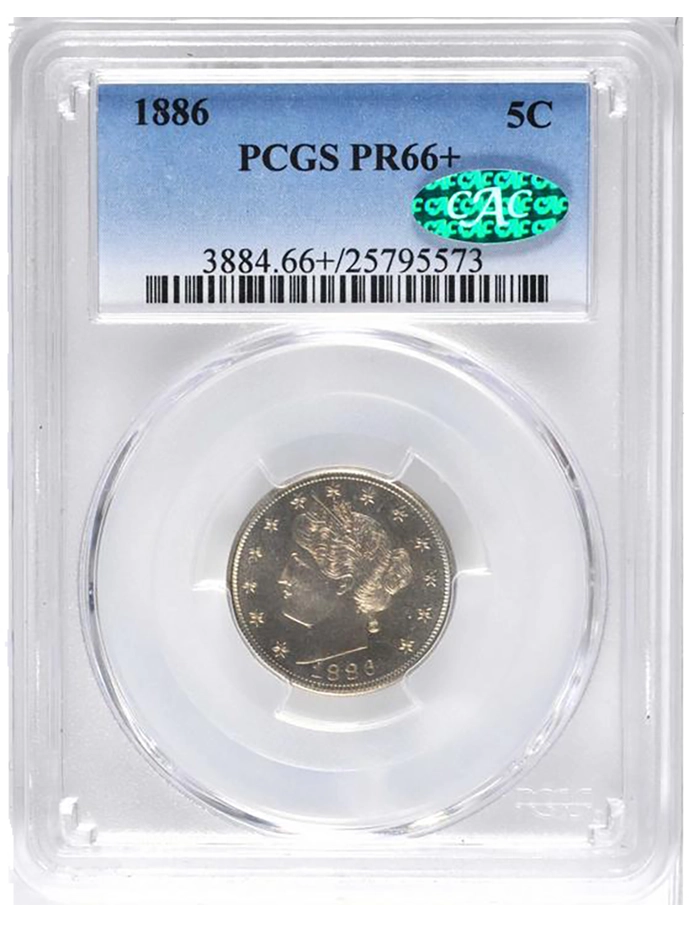
By Greg Reynolds for CoinWeek …..
Link to Part 1: Circulated Liberty Nickels
* * *
This week’s topic is the collecting of uncirculated Liberty Nickels. I focus on those that grade MS-63 or higher, though I mention values for MS-62 grade coins. This discussion is aimed at beginning collectors and/or people who have not yet started sets of uncirculated Liberty Nickels. Type coins are covered as well.
Previously, I put forth an introduction to Liberty Nickels with a focus on circulated coins (see link above). I then emphasized that circulated Liberty Nickels are among the most affordable of all classic U.S. coins. These are wonderful choices for beginners in general and for intermediate collectors who like nickels.
I now point out that Liberty Nickels are among the least expensive of all classic U.S. coins in Choice Uncirculated and Proof grades, coins that grade 63 or higher. It is true, though, that Liberty Nickels that grade above 61 are usually much more expensive than those of the same respective dates that grade under 60.

A set of Choice Uncirculated Liberty Nickels, those that are PCGS- or NGC-graded MS-63 or higher, would probably cost at least $10,000. Much of this total, however, may be attributed to just a few of the 33 coins in the set. The cost of such a set may be reduced by acquiring Proofs of two of the key dates. Proofs of 1885 and 1886 Liberty Nickels are much less costly than business strikes. Also, a set may consist of mostly Choice Uncirculated Liberty Nickels along with some circulated representatives of key and semi-key dates, and could then cost much less than $10,000.
A Gem-quality set of Liberty Nickels, MS-65 and higher grade coins, could easily cost more than $50,000.
But consider, as I explain in Part 1, that only two Liberty Nickels are needed for a type set. These need not be expensive.
Notes About Grades
The grading of uncirculated coins is complicated, and many of the factors involved cannot be explained with words alone. The terms ‘Mint State’ (MS) and Uncirculated are nearly the same. In my view, since the founding of the PCGS in 1986, it has been widely accepted that coins that are not strictly uncirculated may qualify for MS-61 or MS-62 grades, providing that such coins score well in other categories, relating to technical factors, eye appeal, and/or surface quality.

A Liberty Nickel that is PCGS- or NGC-graded MS-60 usually has serious problems, though it may be strictly uncirculated. In relation to Liberty Nickels, I ignore MS-60 and MS-61 grade coins, because these tend to have very undesirable characteristics.
A collector who cannot afford MS-63 grade Liberty Nickels, especially of better dates, may wish to acquire some Liberty Nickels in Extremely Fine or AU grades. While MS-60 to MS-62 coins tend to have problems or controversial issues, problem-free Extremely Fine or AU grade Liberty Nickels of all dates can be found without much difficulty. Some MS-62 grade coins, depending upon their respective individual characteristics may ‘fit better,’ however, into a set of mostly MS-63 and -64 grade Liberty Nickels. So, I mention prices for MS-62 grade coins in this discussion. In some cases, the price of a MS-62 grade coin of a better date Liberty Nickel will be much lower than the price of a MS-63 grade coin of the same date.
Although the primary topic here is Liberty Nickels that grade 63 or higher, there is just no way to explain such grades. Technical factors, eye appeal, and surface quality are major components of such grades. Technical factors relate to scratches, contact marks, and other interruptions of the metal. Surface quality has to do with luster, the degree of originality, the characteristics of toning, among other matters.
By tradition, coins that grade MS-63 or Proof-63 are termed “Choice,” and 64 grade coins are each “Very Choice.” Coins that grade 65 or higher are Gems. A coin that grades 67 is “Superb” or is called a “Superb Gem.” The focus here is on MS-63 to MS-65 grade coins. These are much more available and much more affordable than MS-66 or -67 grade Liberty Nickels.
Type Coins
There are two design types of Liberty Nickels. The first type, ‘No Cents‘, was minted only in 1883. The second type, ‘With Cents‘, dates from later in 1883 all the way to 1912, and it seems that just five Liberty Nickels, all intended to be Proofs, are dated 1913. The main difference between the two types is that the word CENTS does not appear in the design of the first type and does appear in the design of the second type.
 As I emphasized in part one, a type set of just classic nickels is easy to complete, as only five coins are required. Plus, it would be easy to add representatives of all types of Jefferson Nickels to such a type set. Conveniently, all modern nickels are Jefferson Nickels.
As I emphasized in part one, a type set of just classic nickels is easy to complete, as only five coins are required. Plus, it would be easy to add representatives of all types of Jefferson Nickels to such a type set. Conveniently, all modern nickels are Jefferson Nickels.
Liberty Nickels of the first type, ‘No Cents’, are not rare and are hardly even scarce. If these were not one-year type coins, they would be worth very little.
PCGS- or NGC-graded MS-62 ‘No Cents’ nickels tend to sell for between $30 and $50 at auction. A fair retail price would be in the range of $35. Some sell for significantly more at auction because of aesthetic characteristics or because some wholesalers figure that these may be upgraded to MS-63 or 64. Additionally, since less than half of all MS-62 grade 1883 ‘No Cents’ nickels have been certified, collectors who are seeking PCGS- or NGC-graded coins for their respective type sets will be willing to pay more for a certified MS-62 than they would for a not certified coin that is said to grade “MS-62”.
PCGS and NGC have graded at least five hundred DIFFERENT 1883 ‘No Cents’ Liberty Nickels as MS-62. Moreover, there are probably at least seven hundred that are not in holders but would be graded as ‘MS-62’ if submitted. As for MS-63 grade 1883 ‘No Cents’ nickels, there are more than two thousand.
Probably more than three thousand DIFFERENT ‘No Cents’ nickels have been PCGS- or NGC-graded MS-64. For an MS-64 grade ‘No Cents’ nickel, a fair retail price may be $75.
Common Dates
A collector of type coins who demands uncirculated Liberty Nickels for a type set would seek an 1883 ‘No Cents’ coin, which I just discussed, and a ‘With Cents’ type coin. Usually, collectors of type coins are drawn to the least scarce dates in a series.
Many thousands of ‘With Cents’ Liberty Nickels survive in MS-64 and MS-65 grades. Collectors of nickels who can afford a Liberty Nickel that grades at least MS-64 should acquire one. For someone who cannot afford, or does not wish to buy, a MS-64 grade ‘With Cents’ Liberty Nickel, a PCGS- or NGC-graded MS-62 Liberty Nickel may be acquired in an online auction for a price between $50 and $100, when these are available.

Similarly, a ‘common date’ Liberty Nickel ‘With Cents’ in MS-63 grade could easily be acquired via Internet bidding for a price between $90 and $120. A retail price in the range of $130 would usually be fair for one of these. I continue to emphasize, though, that the characteristics of individual coins, not just their respective certified grades, should be taken into consideration. Personally, I would rather pay a little more and have a chance to carefully examine each coin, rather than bid online for coins that I have never seen.
According to Numismedia.com, the least scarce dates in MS-64 and -65 grades are the 1902, the 1903, the 1904, and the 1911. According to the PCGS Price Guide, all the Liberty Nickels dating from 1899 to 1906, and also the 1911 and the 1912, are equally the least expensive in MS-64 and MS-65 grades, “$300” each in MS-64 grade and “$575” in MS-65.
Numismedia, PCGS, and other guides indicate that the 1911 issue is one of the most common dates of the Liberty Nickel ‘With Cents’ design type, perhaps the most common. In recent auctions, prices for PCGS- or NGC-graded MS-64 1911 nickels have ranged from around $145 to around $190.
Auction results, on average, tend to be around the borders between wholesale and retail price ranges. Again, I urge people to read my article ‘What Do Auction Prices Mean‘.
1885 and 1886 Liberty Nickels
The three keys are the 1885, the 1886, and the 1912-S. The 1885 is the princess of the Liberty Nickel series.
While I am tempted to engage in a long discussion about 1885 nickels here, I figure that it is better to analyze this issue at length in the future, separately. Beginning and intermediate level collectors should first acquire other dates in the series, and learn much about Liberty Nickels before acquiring an uncirculated 1885.
Although many more 1886 Liberty Nickels survive in total, in MS-65 and higher grades, the 1886 seems to be even more of a condition rarity than the 1885. Are 1886 Liberty Nickels undervalued in some grades?
Leading price guides tend to value MS-64 grade 1886 Liberty Nickels at more than $4,000. My impression, however, is that the current retail level is around $3,750. Although uncirculated 1886 Liberty Nickels are not as costly as 1885 Liberty Nickels of the same respective grades, these are the more expensive than the other business strikes in the series.
Proofs Instead of Uncs?
While the current topic is uncirculated business strikes, I cannot resist suggesting that collectors mix some Proofs into sets of mostly business strikes, especially Proofs of the 1885 and the 1886. In 62 and higher grades, Proof 1885 and 1886 Liberty Nickels generally cost less than one-third as much as business strikes of the same date that have been assigned the same numerical grade by the same service.
Coin graders John Albanese and Mark Feld agree that collectors should have the option of mixing Proofs and business strikes in the same sets.
“I do not see why not,” Albanese remarks. “People do not have to register their sets … Collectors should make decisions for themselves. Many collectors in the old days mixed Proofs and business strikes in the same sets.”

In this regard, the “old days” were not that long ago. Until the 1980s, a very large percentage of collectors viewed Proofs as being superior to business strikes. Since around 1990, however, the trend has been for collectors to interpret Proofs as merely being products of different methods of manufacture, rather than being superior items or more important in general. Indeed, many collectors now view Proofs as being less important than business strikes.
As I discussed in a much different context, throughout the history of coin collecting in the U.S., most leading collectors strongly preferred Proofs and sought business strikes when Proofs were not available. Louis Eliasberg, the Norwebs, Floyd Starr, the Garretts, and many others mixed Proofs and business strikes in the same sets. Usually, when they had a Proof of a given type and date, they did not regard a business strike of the same type and date as being needed or as an enhancement.
The traditional approach is to include Proofs and business strikes in the same sets and the new approach is to regard the collecting of Proofs and business strikes of the same coin type as two separate undertakings, with no overlap. My immediate point is that the traditional rules, in this context, are still legitimate. Collectors should not feel compelled to follow current PCGS rules rather than rules followed by Louis Eliasberg and the Norwebs, among many others, over the history of coin collecting in the U.S.
1912-D and 1912-S
Although Three Cent Nickels were first minted in 1865 and five-cent nickels were first minted in 1866, all nickels were struck at the ‘headquarters’ mint in Philadelphia before 1912. The 1912 Denver Mint issue is not quite a key date, though it is a better date.
The 1912 San Francisco Mint nickel is much scarcer than the 1912-Denver Mint nickel. In Part 1, I discussed prices for circulated 1912-S Liberty Nickels. These are relatively expensive. Collectors who do not wish to, or are not ready to, buy a Choice Uncirculated 1912-S may wish to obtain a circulated 1912-S.

The toning on 1912-S nickels is often colorful. Albanese points out that these tend to exhibit a “light green to blue hue, different colors than [those found on] 1912-P and 1912-D nickels.”
While natural toning on 1912-S nickels is often really neat, not all toning is natural. I suggest being careful. I have seen more than a few artificially toned Liberty Nickels of better dates, especially 1912-S nickels, in PCGS and NGC holders. Before spending thousands for a MS-64 or higher grade 1912-S nickel, buy common dates for at least a few months and discuss 1912-S nickels with experts.
In general, collectors should start by spending amounts that they each regard as not large. It is a good idea to read about coins and ask questions. Furthermore, it makes sense to think about a collecting strategy and a collecting budget. Liberty Nickels are excellent choices for collectors who like nickels, who wish to complete type or date sets, and who would like to buy classic U.S. coins for relatively low prices. Similar collections of other classic U.S. coin series are usually much costlier.
* * *





Great article for putting together a great set of any series!
Why is a pr64 cameo (1 of 3790 proofs made) & ( less as pr64 cameo ) valued far less than the business strike (1,476,490) minted in 1885 liberty v- nickels (key date) ??? I am really just confused I guess ! I have a huge collection of most American coin sets (completed) and double sets of several ! Years of collecting and this always has bothered me ! Thanks for any input and/or reply, truly Dave